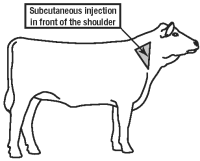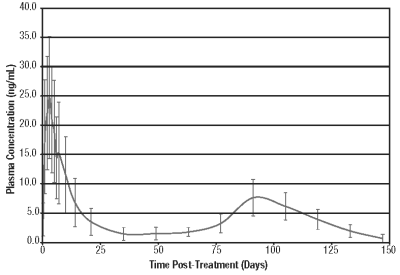LongRange (Canada)
This treatment applies to the following species: Company: Boehringer Ingelheim
Company: Boehringer Ingelheim
Eprinomectin Extended Release Injection
Sterile
DIN 02450798
VETERINARY USE ONLY
Active Ingredient
Each mL contains 50 mg of eprinomectin.
LongRange Indications
LONGRANGE® is indicated for the treatment and control of the following internal and external parasites of cattle aged 6 weeks or older:
Gastrointestinal Roundworms
Bunostomum phlebotomum - Adults and L4
Cooperia oncophora - Adults and L4
Cooperia punctata - Adults and L4
Cooperia surnabada - Adults and L4
Cooperia spp. - Inhibited L4
Haemonchus contortus - Adults
Haemonchus placei - Adults
Nematodirus helvetianus - Adults and L4
Oesophagostomum radiatum - Adults and L4
Ostertagia lyrata - Adults
Ostertagia ostertagi - Adults and L4
Ostertagia spp. - Inhibited L4
Trichostrongylus axei - Adults and L4
Trichostrongylus colubriformis - Adults and L4
Lungworms
Dictyocaulus viviparus - Adults
Grubs
Hypoderma bovis
Mites
Sarcoptes scabiei var. bovis
Second Phase Of Effectiveness
Due to the pharmacokinetic properties of LONGRANGE® a second phase of activity has been shown to be effective at eliminating the following parasites at these times after treatment:
|
Parasites |
Days post-treatment |
|
Gastrointestinal Roundworms |
|
|
Bunostomum phlebotomum |
120 days |
|
Cooperia oncophora |
120 days |
|
Cooperia punctata |
120 days |
|
Oesophagostomum radiatum |
120 days |
|
Ostertagia lyrata |
120 days |
|
Ostertagia ostertagi |
120 days |
|
Trichostrongylus axei |
100 days |
|
Lungworms |
|
|
Dictyocaulus viviparus |
150 days |
LongRange Dosage And Administration
LONGRANGE® should be given only by subcutaneous injection in front of the shoulder at the recommended dosage level of 1 mg eprinomectin per kg body weight (1 mL per 50 kg body weight).
Each mL of LONGRANGE® contains 50 mg of eprinomectin, sufficient to treat 50 kg body weight. Divide doses greater than 10 mL between two injection sites to reduce occasional discomfort or injection site reaction.
|
Body Weight |
Dose Volume (mL) |
|
|
kg |
lb |
|
|
50 |
110 |
1 |
|
100 |
220 |
2 |
|
150 |
330 |
3 |
|
200 |
440 |
4 |
|
250 |
550 |
5 |
|
300 |
660 |
6 |
|
350 |
770 |
7 |
|
400 |
880 |
8 |
|
450 |
990 |
9 |
|
500 |
1100 |
10 |
Animals should be appropriately restrained to achieve the proper route of administration. Inject under the loose skin in front of the shoulder (see illustration) using a 16 or 18 gauge, 1/2 to 3/4 inch needle.

Administration in this injection site is important for an optimal release profile of the product.
Sanitize the injection site by applying a suitable disinfectant. Clean, properly disinfected needles should be used to reduce the potential for injection site infections.
Use only polypropylene syringes or automatic polypropylene dosing equipment.
When to Treat Cattle with Grubs:
Inappropriate timing of treatment for cattle grubs with an effective anthelmintic can result in serious adverse reactions. Proper timing of treatment is important. For the most effective results, cattle should be treated as soon as possible after the end of the heel fly (warble fly) season. Destruction of Hypoderma larvae (cattle grubs) at the period when these grubs are in vital areas may cause undesirable host-parasite reactions, including the possibility of fatalities. Killing Hypoderma lineatum when it is in the tissue surrounding the esophagus (gullet) may cause salivation and bloat; killing H. bovis when it is in the vertebral canal may cause staggering or paralysis. Consult your veterinarian concerning the proper time for treatment.
LongRange Cautions
For subcutaneous use only.
Local tissue reaction may result in trim loss of edible tissue at slaughter.
The safety of LONGRANGE® has not been evaluated- in calves less than 6 weeks of age.
Not recommended for use in cattle managed in feedlots or under intensive rotational grazing.
Note:
Underdosing and /or subtherapeutic concentrations of anthelmintic products may encourage the development of parasite resistance. It is recommended that parasite resistance be monitored following the use of any anthelmintic with the use of a Fecal Egg Count Reduction Test (FECRT) program. There are several measures that can be implemented to help mitigate the risk of resistance, including:
- Anthelmintics should be used in the framework of an integrated parasite control program that should also include measures such as grazing management.
- Avoid indiscriminate use of anthelmintics.
- Carefully follow the instructions given in the section DOSAGE AND ADMINISTRATION. Weigh or estimate the weight of animals as accurately as possible in order to avoid underdosing. Dosing equipment/syringes should be checked regularly for proper calibration.
- Monitor the herd parasite status using methods such as Fecal Egg Counts (FEC).
Consult your veterinarian for the diagnosis, treatment, and control of parasitism.
WARNINGS
● Treated cattle must not be slaughtered for use in food for at least 120 days after the latest treatment with this drug.
● Do not use in dairy cattle 20 months of age or older, including dry dairy cows.
● Do not use in calves to be processed for veal. A withdrawal period has not been established for pre-ruminating calves.
● Do not re-administer the product to cattle within six months to ensure that the Maximum Residue Limits are not exceeded, including at the injection site.
● High oral doses of eprinomectin cause neurotoxicity in laboratory animals. Avoid contact with skin and eyes. If accidental skin contact occurs, wash the affected area immediately with plenty of water. If accidental eye exposure occurs, rinse immediately with plenty of water and seek medical advice. If accidental swallowing occurs, seek medical advice immediately and show the container or the package insert.
● Keep out of reach of children.
Adverse Reactions
Although all adverse reactions are not reported, the following information is based on voluntary post-approval drug experience reporting. It is generally recognized that this results in significant under-reporting. The adverse events listed here reflect reporting and not necessarily causality. The following adverse events were reported very rarely (<0.01%) in decreasing order of frequency:
Lack of efficacy, death (most often associated with anaphylaxis), recumbency, injection site edema, lethargy.
In trial data transient injection site reactions including granulomas and necrosis have been observed in some animals. These reactions have disappeared without treatment.
Environment
As with other avermectins, eprinomectin is excreted in the dung of treated animals and can inhibit the reproduction and growth of pest and beneficial insects that use dung as a source of food and for reproduction. The magnitude and duration of such effects are species and life-cycle specific. When used according to label directions, the product is not expected to have an adverse impact on populations of dung-dependent insects.
Not for use in cattle managed in feedlots or under intensive rotational grazing because the environmental impact has not been evaluated for these scenarios.
Studies indicate that when eprinomectin comes in contact with soil, it readily and tightly binds to the soil and becomes inactive over time. Free eprinomectin may adversely affect fish and certain aquatic organisms. Do not contaminate water by direct application or by improper disposal of drug containers. Dispose of containers in an approved landfill or by incineration.
Clinical Pharmacology
Description
LONGRANGE® is a ready-to-use, sterile injectable preparation containing eprinomectin, a member of the macrocyclic lactone class of antiparasitics. Each mL of LONGRANGE® contains 50 mg of eprinomectin in a co-solvent system of N-Methyl Pyrrolidone (30% v/v) and triacetin (qs), along with 50 mg of Polylactic/Glycolic-acid (PLGA) polymer. Extended release from this polymer results in two plasma peaks of eprinomectin. Butylated hydroxytoluene (0.2 mg/mL) acts as an antioxidant in the formulation.
The chemical name of eprinomectin is 4”-deoxy-4”-epiacetylaminoavermectin B1. It is a semi-synthetic member of the avermectin family of compounds consisting of a mixture of two homologous components, B1a and B1b, which differ by a single methylene group at C26.
Mode of Action:
The macrocyclic lactones have a unique mode of action. Compounds of this class bind selectively and with high affinity to glutamate-gated chloride ion channels that are present in invertebrate nerve and muscle cells. This leads to an increase in the permeability of the cell membrane to chloride ions with hyperpolarization of the nerve or muscle cell, resulting in paralysis and death of the parasite. Compounds of this class may also interact in other ligand-gated chloride ion channels, such as those gated by the neurotransmitter gamma-aminobutyric acid (GABA).
The margin of safety for compounds of this class is at least partially attributable to the fact that mammals do not have glutamate-gated chloride ion channels, and that the macrocyclic lactones have low affinity for other mammalian ligand-gated channels and do not readily cross the blood-brain barrier.
Pharmacokinetics:
When LONGRANGE® is injected subcutaneously in the shoulder area of cattle, a polymeric PLGA matrix is formed. The biodegradable matrix solidifies in vivo to form a gel, which results in two peaks of eprinomectin release from the formulation.
The main route of excretion for eprinomectin is via the feces. Levels of eprinomectin slightly above the limit of detection have been found for up to 230 days post injection with LONGRANGE®.
Mean Eprinomectin B1a Plasma Concentration versus Time Following a Single Subcutaneous Injection of LONGRANGE® at a Dose Rate of 1 mg Eprinomectin per kg Body Weight in Beef Cattle
(Arithmetic Mean ± Standard Deviation of the Mean, n=42)

Animal Safety
Clinical studies have demonstrated an adequate margin of safety of LONGRANGE®.
Treatment-related lesions observed in cattle administered the product included swelling, hyperemia or necrosis in the subcutaneous tissue of the skin. The administration of LONGRANGE® at 3 times the recommended therapeutic dose had no adverse reproductive effects on beef cows at all stages of breeding or pregnancy or on their calves.
The administration of LONGRANGE to breeding males at 3 times the recommended therapeutic dose had no adverse effects on scrotal circumference, libido, semen quality, or sperm characteristics.
Storage
Store at room temperature between 15 - 30°C with excursions up to 40°C permitted as long as they do not exceed 48 hours. Protect from light.
50 mL and 100 mL bottle size: Use only polypropylene syringes. Discard bottle after 15 stopper punctures, or 2 months after stopper has been punctured, whichever comes first. Avoid introduction of contamination.
250 mL and 500 mL bottle sizes: Use only polypropylene syringes or automatic polypropylene dosing equipment. Automatic dosing equipment should be thoroughly cleaned after each use. Discard bottle after 15 stopper punctures, or 3 months after stopper has been punctured, whichever comes first.
PRESENTATION
LONGRANGE® is available in ready-to-use glass bottle of 50, 100, 250 and 500 mL containing sufficient solution to treat 10, 20, 50 and 100 heads of 250 kg cattle, respectively. Not all pack sizes may be marketed.
Boehringer Ingelheim Animal Health Canada Inc., 5180 South Service Road, Burlington ON L7L 5H4
LONGRANGE® is a registered trademark of Boehringer Ingelheim Vetmedica GmbH, used under license.
CPN: 1182154.1
5180 SOUTH SERVICE ROAD, BURLINGTON, ON, L7L 5H4
| Customer Care No.: | 1-800-567-1885 | |
| Technical Services No.: | 1-877-565-5501 | |
| Website: | www.boehringer-ingelheim.ca |
 |
THIS SERVICE AND DATA ARE PROVIDED "AS IS". Animalytix assumes no liability, and each user assumes full risk, responsibility, and liability, related to its use of the Animalytix service and data. See the Terms of Use for further details. |

Copyright © 2024 Animalytix LLC. Updated: 2024-02-27
